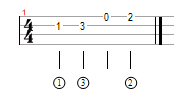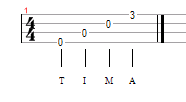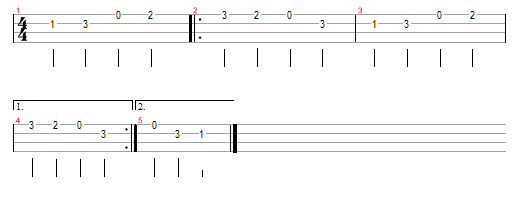Fingering Positions
When the fingering of a certain passage is important, tab will give a guide as to which fingers should be used both for fretting and picking.
Fretting Hand
The fretting hand (the left hand for right-handed players) is indicated by numbers in circles underneath the tab.
The index finger is 1, middle finger 2 etc. When strings are played open, no finger is indicated.
Picking Hand
 The tab for the picking hand is less intuitive.
The tab for the picking hand is less intuitive.
T = Thumb
I = Index Finger
M = Middle Finger
A = Ring Finger
The finger names come, apparently, from Latin (indice, medius, annular).
These letters appear under the tab also.
Repeats
There are a number of ways that repeats are shown in tabs. The main way is with a set of double bar lines (one thick and one thin) and two dots.
When you come across a set of these with the dots facing right, you skip straight past them. When the dots are facing left, you go back to the first set (where the dots are facing right) and play through again. The second time you reach the repeat sign, play straight through it unless it indicates otherwise (by say x3, x4 etc.).
In this example, you play bar one and bar two, then bar two again.
If there is no first set of repeat signs, go back to the beginning and play through again.
Sometimes you’ll see sections at the end of each repeat blocked off like this:
Here you play the bar underneath the 1 section the first time round, follow the repeat sign as normal, then second time round you skip that bar and play the bar underneath the 2 instead.
So, you’d play bars:
1, 2, 3, 4, 2, 3, 5
The section under the 1 can be any number of bars – the idea remains the same.
You can also have any number of alternate bars. If the section is repeated 4 times, there may be 4 different endings written. You just play these in sequence the same way..
.
Read the rest of the series here: How to Read Ukulele Tab.
This series was derived from my ebook Ukulele 101: 101 Things Every Ukulele Player Needs to Know.








Thanks for the tutorial. I have been learning “Hene” from John King’s book and he uses some real intense notation in his book “Famous Solos and Duets for the Ukulele” Your tutorials are very useful.